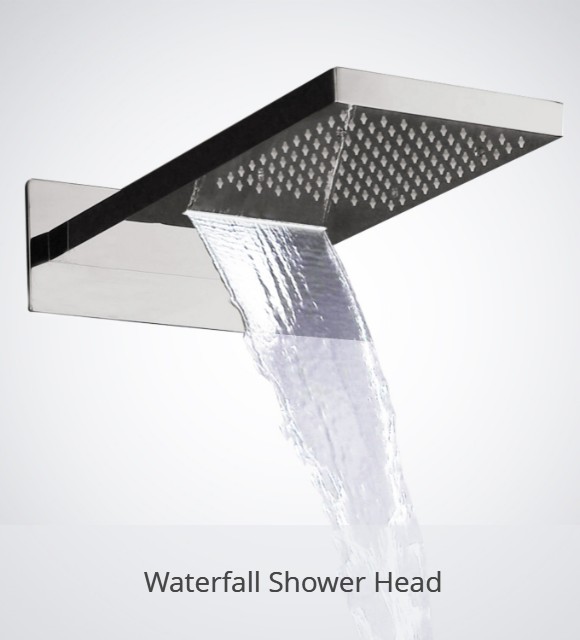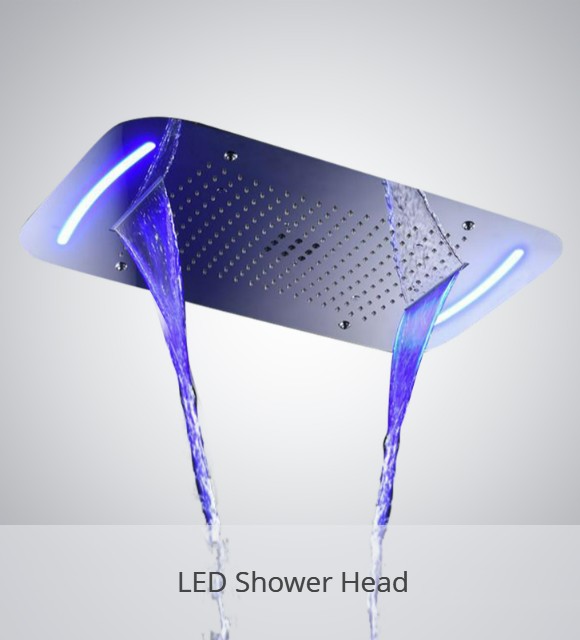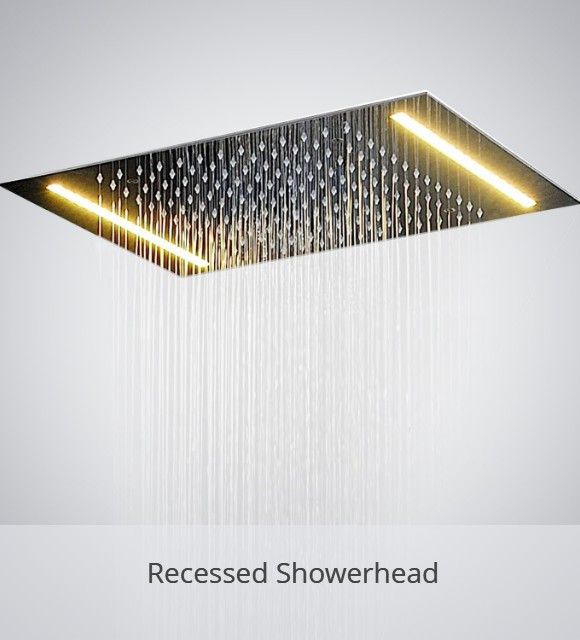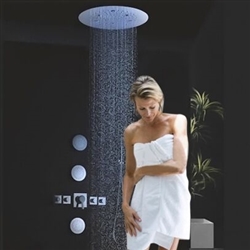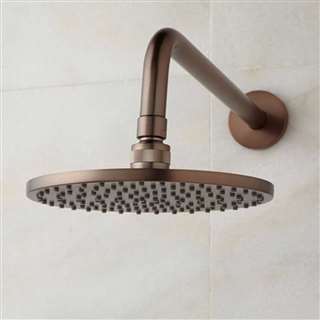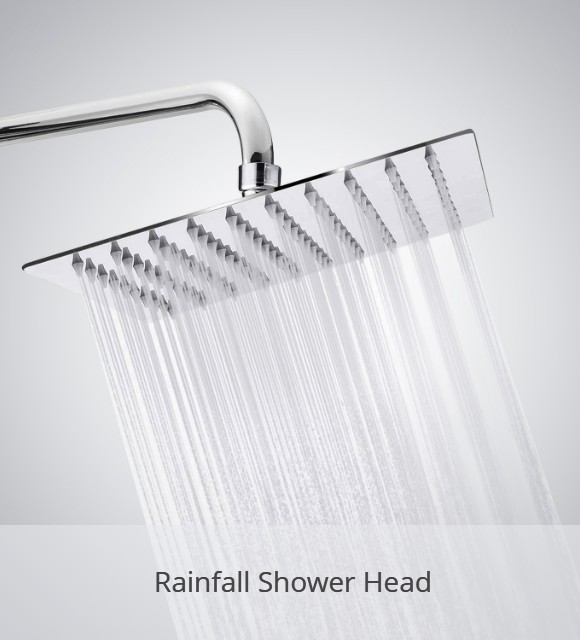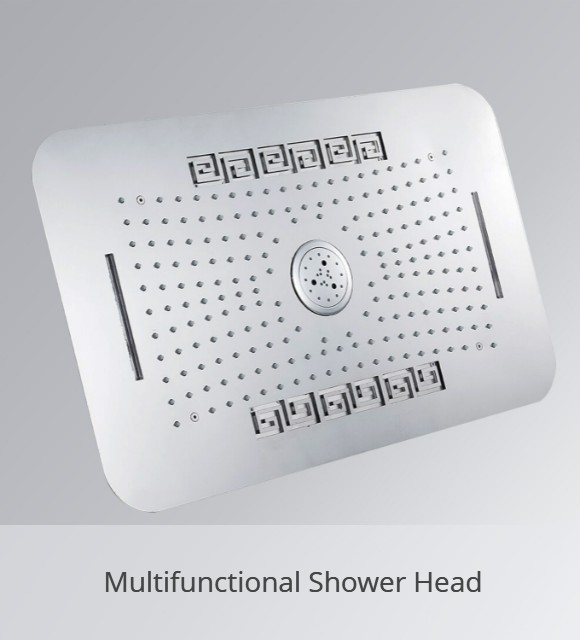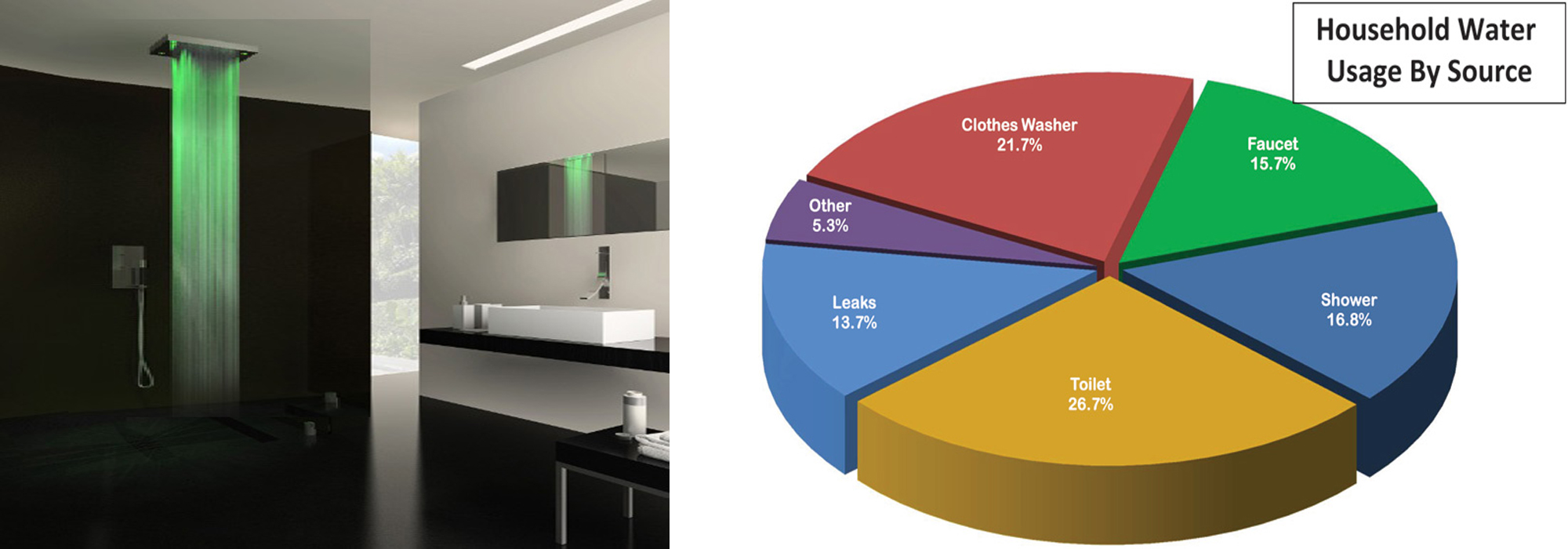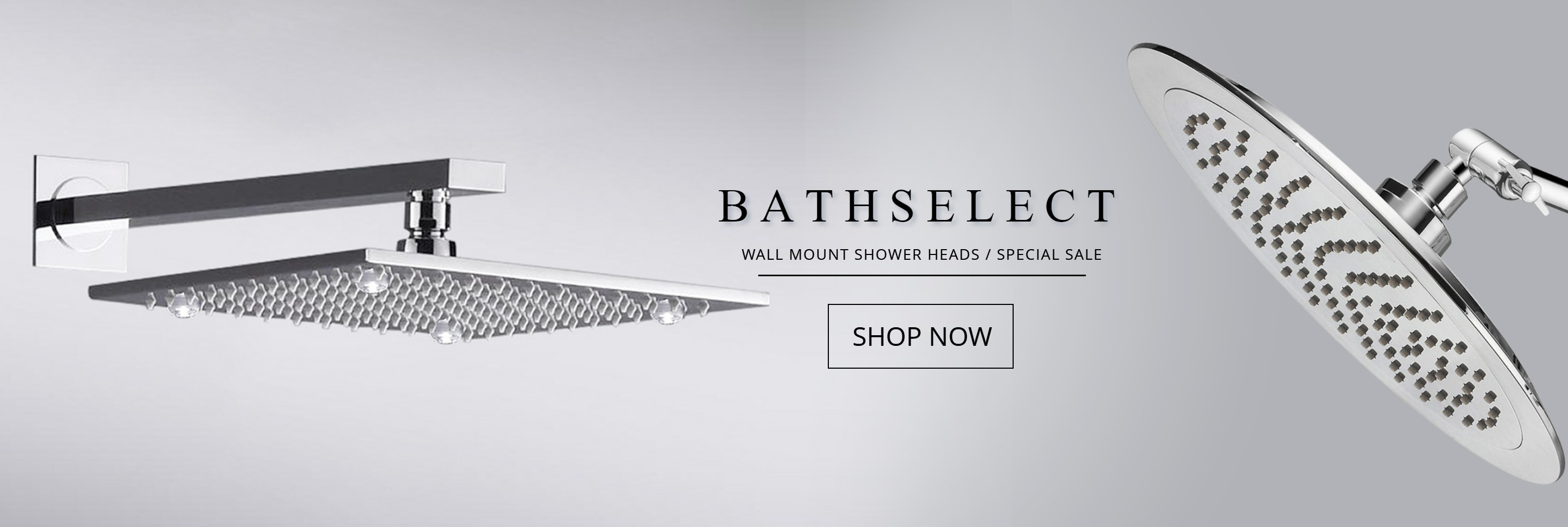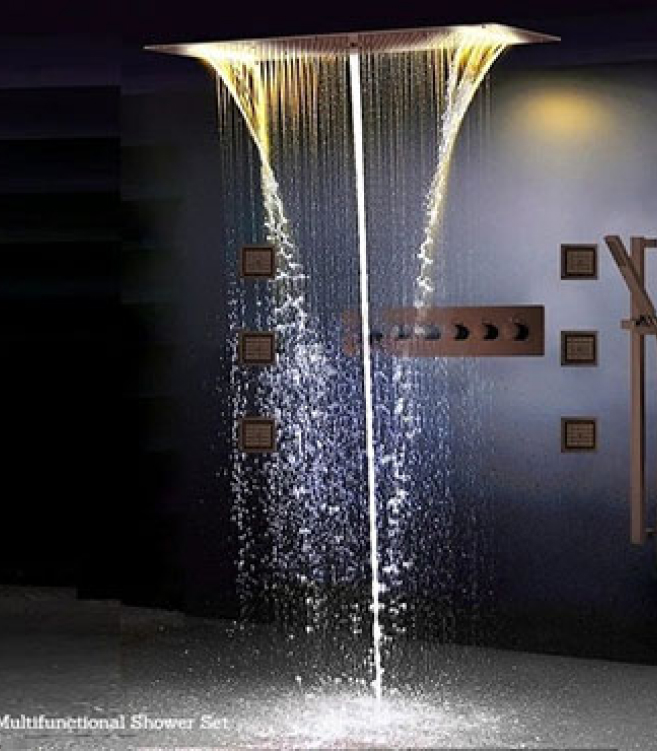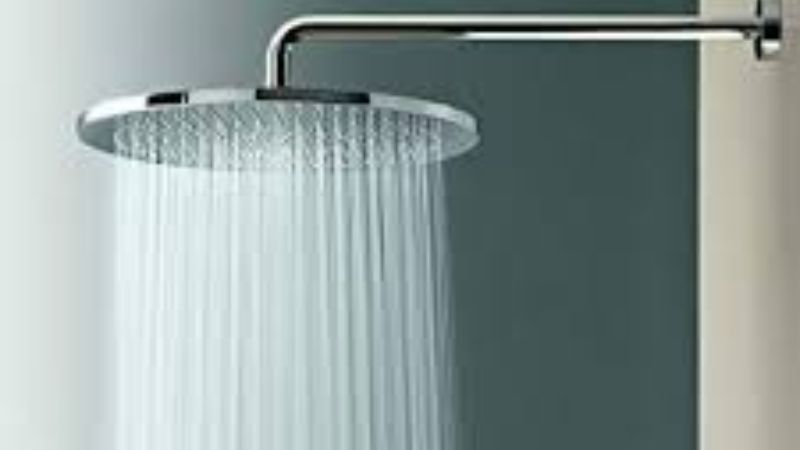Unlock Optimal Shower Bliss: Discover the Perfect Flow Rate and Gallons Per Minute for Your Ideal Shower Experience

What is the Shower Head Flow Rate?
This is the flow rate of the shower head, which is simply the quantity of water, usually measured in gallons per minute (GPM) or liters per minute (LPM), passed through a showerhead in one minute. This rate determines the strength or weakness of the water flow during a shower. It typically means that the higher the flow rate, the stronger and more invigorating the shower will be; the lower, the more gentle and water-saving. Knowing the flow rate will help to have a shower head that satisfies both the preferences of one in terms of water pressure and efficiency.
Shower Heads
![]()
85 billion gallons of water savings per year, if everybody in the United States could use one less gallon of water per shower every day. Impressive—how does one do this?
Adopting water-saving habits allows users to play an active role in the sustainable and responsible use of this precious resource. However, cutting down on water consumption from the showerhead is far from fitting low-flow models. There are many other techniques or ways to reduce the consumption effectively from the showerhead alone.
![]()
Revealed: How Much Water Does Your Shower Really Use?
By law, the maximum flow rate for showerheads in the United States is 2.5 gallons per minute; however, many showerheads could have a flow rate higher or lower than that, usually between 1.5 to 4.0 GPM, while others can give higher flow rates as high as 5.5 GPM or more. Therefore, it is always very important to confirm the flow rate of a showerhead before making your choice or buying one.
There are some types of high-flow shower heads available in the market; such types of showerheads transcend the legal limit with the aim of providing a more invigorating shower experience. Normally, high-flow showerheads will manage to produce a stronger water pressure, accounting for a forceful and satisfying sensation while showering.
The other way around, several showerheads are available with lower flow rates that are designed to propagate water conservation. Low-flow showerheads are designed to reduce the volume of water that comes out per minute while providing a comfortable shower experience. They do this through technologies like aerators or flow restrictors that mix air with water to create a satisfying spray pattern while reducing overall water consumption
The average American family uses over 300 gallons of water per day, with about 70% of this usage occurring indoors (US EPA).
It is therefore important to note that flow rates between many showerhead models and brands vary tremendously. Some will be right at, slightly above, or below the legal limit; others still go further from it. One chooses a showerhead based on personal preference in pressure, conservation goals, or local regulations regarding water usage.
![]()
Low-flow showerheads are intended to restrict the volume of water that may pass through per minute while maintaining a comfortable shower for the user. The answer can be provided in several ways: either by an aerator or flow restrictor, which mixes air into the water to achieve a satisfactory spray pattern while reducing total water usage.
Toilets, showers, and faucets are the primary consumers of water in a household. On average, toilets use 33 gallons of water per day, while showers and faucets use 27 gallons each (Water Usage Stat).
Due to variations in flow rate restrictions across different states, BathSelect recognizes the need to accommodate diverse low flow rate requirements. In order to address this, BathSelect offers the flexibility of providing different aerators upon request. By offering a range of aerators, BathSelect ensures that our best rated shower heads are customized with different flow rates to comply with specific regulations in the respective states. This approach allows customers to enjoy the benefits of water conservation while adhering to the flow rate restrictions set by local authorities. Whether it’s a higher flow rate for areas with less stringent regulations or a lower flow rate to meet strict conservation standards, BathSelect strives to fulfill customers’ specific low flow rate needs by offering suitable aerators tailored to their individual requirements.
![]()
It can save gallons of water and energy by bringing down the flow rate of your showerhead, which will save money on utility bills and contribute to a greener environment.
On average, a shower uses about 17 gallons of water when used for 8 minutes on average. Typical or standard showers will consume 2.5 gallons per minute. According to EPA showering in the United States represent 17% of indoor water home use, which is about 40 gallon of water per family home per day or 1.2 trillion gallons of water per year for the United States. So how can we improve on Water usage namely during showering? Simple if you keep the shower pressure lower or make your showers few seconds shorter. The second part is easy but what about the keeping shower pressure lower, in other words, when you buy a shower, be it a shower system or a shower head, or a shower faucet need to look for the shower head flow rate. Some of theses shower head and shower system will display the flow rate which is GPM ( Gallon Per Minute) and naturally the higher the gpm the higher the water flow. Usually, a typical shower head flow rate is anywhere between 1.5 GPM and 3.7 GPM, while a shower system with massage body jets and rainfall shower head with waterfall shower head gpm will be around 3.8 GPM.
![]()
Shower Head Flow Rate
Typically the standard shower head uses an average flow rate of 2.5 gpm, this means how many gallons of water flows out of the shower head each minute which is 2 and half gallons of water per minute. This flow rate has become the standard. However in the past the average flow rate of a shower head was much higher than this. Also, you will find low flow showers , with flow rate such as 1.8 gpm, which means for every 10 minutes of showering, you will use 18 gallons of water. In the past decade more states have set rules for the shower head waterflow for example New York City adopted a 2.0 GPM standard in 2010, while Colorado adopted a 2.0 GPM standard in 2016, and more recently California adopted a 1.8 GPM shower head flow rate standard in July 2018
![]()
Did you know outdoor water use accounts for more than 30% of household water use on average but can rise to as much as 60% in arid regions. Inefficient irrigation systems can waste up to 50% of outdoor water use due to wind, evaporation, and runoff (US EPA).
It should be noted that the main part of the such shower head regulations and water flow restrictions are made by each state in the United States. The rules may change within high flow showerhead and should be looked up according to the local authority or newest legislation in your state. However, it is known that some states have fewer water flow for shower restrictions than others.
![]()
Shower Head Flow Rate Regulations by State and Locality
California
California has implemented regulations restricting the maximum flow rate showerhead to 2.0 gallons per minute (GPM). However, certain types of such as rain showerhead, may be exempt from these restrictions.
New York
New York enforces a maximum showerhead flow rate for of 2.0 GPM.
Texas
Currently, Texas does not have statewide regulations specifically limiting showerhead flow rate. It is advisable to check with local authorities or utility providers as there may be local ordinances in place.
Florida
As of December 2022, Florida does not have statewide regulations specifically governing the flow rate of basic average showerhead. However, it is recommended to consult local authorities or utility providers for any local restrictions.
Flow Rate Regulations by County
- West Hollywood, California – 1.5 GPM
- California (general) – 1.8 GPM
- Scottsdale, Arizona – 2.0 GPM
- Ft. Collins, Colorado – 1.8 GPM
- Colorado (general) – 2.0 GPM
- Miami-Dade County, Florida – 1.5 GPM
- Broward County, Florida – 2.0 GPM
- Hawaii – 1.8 GPM
- Chicago, Illinois – 2.0 GPM
- Massachusetts – 2.0 GPM
- Rockville, Maryland – 2.0 GPM
- Nevada – 2.0 GPM
- New Jersey – 2.0 GPM
- New York City – 2.0 GPM
- Oregon – 1.8 GPM
- Vermont – 2.0 GPM
- Washington – 1.8 GPM
- Washington D.C. – 2.0 GPM
Note: To convert liters per minute (LPM) to gallons per minute (GPM), please refer to the FAQ section.
![]()
![]()
Shower Flow Rates: What’s Typical and How Much Water Do You Really Use?”
Testing shower GPM (Gallons Per Minute) can be done in a few ways. More common methods of measurement include the use of a flow meter. This device is specially designed to measure the rate of water flow with accuracy. Another method uses a bucket with marked volumetric graduations and a timer. In this case, the user just measures the time it takes to fill the bucket to a desired level. Alternatively, the showerhead output can be collected in a measuring container with volume markings for a given time, and then the volume is divided by the time to obtain the GPM. This must be repeated several times and the resultant average computed to ensure accuracy. This would account for any variations in water pressure during the measurements.
Did you know household leaks can waste approximately 180 gallons per week, totaling nearly 9,400 gallons annually per household. Nationally, this amounts to almost 900 billion gallons of water wasted each year, equivalent to the annual water use of nearly 11 million homes (US EPA)
Does a bath or a shower use more water? and how many gallons per minute does a shower use? The typical flow rate of a shower system may differ from a flow rate of a shower head. Shower system may encompass handheld shower, body shower spray, tub spout and other shower fixtures.
![]()
The Shower Head Water Flow
BathSelect’s guide on shower head water flow types explains how different flow rates and patterns impact water efficiency and user experience, helping customers choose the ideal option.
Read about shower head water flow hereBenefits of Choosing the Best High-Pressure Rain Shower Head
This article highlights the advantages of high-pressure rain shower heads, detailing how they enhance water coverage and provide a more invigorating shower experience.
Explore the benefits hereSatin Nickel or Brushed Nickel Bathroom Fixtures?
BathSelect compares satin and brushed nickel finishes, offering insights on their durability, visual appeal, and how each finish fits into various bathroom designs.
Learn more hereFAQ: Best Luxury Shower Heads
BathSelect answers common questions about these luxury showers, covering features, materials, and performance to help customers make a premium choice for their bathrooms.
Read the FAQs hereWorst Showerheads to Buy
This article provides an honest look at showerheads to avoid, listing common issues and inferior features to help customers make a better-informed purchase.
Find out more here
![]()
How to remove flow rate restrictor ?
The flow rate restrictor is a small device installed within most modern water fixtures to control and restrict the volume of water flowing through them. They are a design for water conservation and to conform with regulatory standards. Nevertheless, some users may find that restrictors impede water pressure or do not meet personal preference requirements in water flow. Therefore, the following is a step-by-step process regarding how to remove a flow restrictor and the technical changes by altering the flow rate.
Step-by-Step Process to Remove a Flow Restrictor
Tools Required
Gather the following tools before starting the process:
Adjustable wrench
Needle-nose pliers
Teflon tape
Soft cloth (to protect the fixture’s finish)
A screwdriver or small pin
Disassemble the Fixture
Begin by unscrewing the connecting part of the fixture from the plumbing outlet. Use the adjustable wrench, and wrap the fixture in a soft cloth to avoid scratching the surface.
Removed, look at the base. The flow restrictor is typically located within the inlet.
Identify the Restrictor
The restrictor can be a small, round plastic piece with perforations, secured by a rubber washer or O-ring.
Very carefully remove the rubber washer or O-ring with needle-nose pliers to reveal the restrictor.
Remove the Restrictor
Insert a pin or small screwdriver through the perforations of the restrictor. Gently wiggle it out of place being careful around surrounding components.
If the restrictor won’t easily budge, apply gentle pressure working carefully to avoid puncturing or distorting the component.
Reassemble the Fixture
Replace the O-ring and washer into their home positions.
Reattach the fixture to the plumbing outlet and apply Teflon tape to the threads for a watertight seal. Tighten securely, but avoid overtightening, as this can cause cracks in the housing.
Check the Water Flow
Turn the water on and check the flow. The flow should be free of leaks and at a pressure that suits your preference.
Effects of Changing the Flow Rate
Removal of a flow restrictor significantly alters water flow and encompasses practical and regulatory implications as well. Details on the effects follow.
Increased Water Pressure
Removing the restrictor doesn’t throttle the water fixture; hence, water can flow at full pressure. This is quite helpful for areas that are naturally low in water pressure, where the restrictor may get in the way of a good experience.
Higher Water Consumption
Flow restrictors are designed to cap the flow to around 1.8 to 2.5 GPM, in accordance with water conservation standards such as that of the EPA‘s WaterSense program. They can go up to 3-5 GPM and even more without the restrictor, thus extensively driving up water consumption.
Increased water usage translates to higher utility bills and possible violation of local restrictions on water use.
Impact on Water Heating Systems
Higher flow rates strain the water heating systems, as more heated water is demanded to keep the temperature consistent. This may lead to non-uniform heating, quicker running out of hot water, and higher energy costs.
Environmental Impact
Removing the restrictor cancels this water-saving advantage, thereby contributing toward greater water wastage and a larger environmental footprint. This is particularly important in areas prone to drought or with scarce water resources.
Change in Spray Patterns
Many fixtures are engineered with specific flow rates to optimize spray patterns. Removing the restrictor may disrupt this balance, causing uneven distribution or reduced aeration in the water output.
Regulatory Compliance
Removing, tampering, or drilling into the flow restrictor will void warranties and make the fixture not compliant with federal and state regulations. The Energy Policy Act of 1992 requires that flow rates in residence cannot exceed 2.5 GPM. Violation of these stipulations can lead to fines or cause problems with their home inspections.
Essential Things to Consider Before a Flow Restrictor Is Removed
Verify local regulations
Understand how local water conservation laws and regulations work. This can affect whether removing the restrictor will make your fixture no longer conform to required standards, which could be an issue legally or financially.
Check for Water Pressure Problems
Most times, perceived low water pressure is due to clogged aerators or mineral buildup; not the actual restrictor. Cleaning the fixture may well resolve these issues without removing the restrictor.
Use Adjustable Flow Models
Consider instead fixtures with an adjustable flow setting, which will allow some flexibility in water pressure while remaining compliant.
Document Changes
If there is a need for removal, document the process and retain the restrictor for reinstallation if it becomes necessary for compliance or resale purposes.
By understanding the function and implications of flow restrictors, users can make informed decisions about modifying water fixtures. Removing the restrictor may allow for better water pressure and a superior end-user experience; however, it increases water and energy consumption, thus disrupting eco-friendly practices and possibly involving regulatory consequences.
Why BathSelect Recommends the Use of a Flow Rate Restrictor and Its Effects on Water Flow
BathSelect incorporates a flow rate restrictor into water fixtures to solidify their commitment to sustainability, efficiency, and adherence to the latest water conservation standards. These restrictors are pivotal to amplifying water use efficiency without skimping on performance and ensuring a great user experience.
Why BathSelect Recommends Flow Rate Restrictors
Water Conservation and Sustainability
The flow restrictors serve to regulate water output, generally restricting flow to 1.8 to 2.5 gallons per minute. This serves to conserve unnecessary water usage and is in line with most global sustainability endeavors. BathSelect supports this feature as it ensures good management of resources, especially for those regions that experience inadequate water supply.
Energy Efficiency
Control of water flow decreases the energy consumption to be used in heating water, since less volume is treated. The result will be a lessened utility bill and will also advocate for eco-friendly measures. By integrating restrictors, BathSelect ensures its fixtures align with energy conservation goals.
Performance Optimized
Modern fixtures are engineered to deliver a balanced and consistent output within regulated flow rates. Restrictors maintain the design integrity of these fixtures by assuring a proper mix of water pressure, spray pattern, and aeration. BathSelect uses this principle in its designs, striving to ensure user satisfaction without sacrificing efficiency.
Regulatory Compliance
BathSelect’s products are designed to comply with local and international water conservation standards, such as the EPA’s WaterSense program in the United States. Flow restrictors help meet these regulations, ensuring that products remain compliant for residential and commercial use.
Cost Savings for Users
In addition, by reducing the volume of water coming through, they help the users save on water and energy bills, particularly in environments characterized by heavy traffic, including hotels, offices, and public restrooms.
Different Flow Rates, Different Impacts
Perhaps the most considerable way in which flow rate can influence the efficiency, usability, and environmental impact of a water fixture is listed below:
Low Flow Rates (1.5–2.0 GPM)
Pros:
Maximizes water conservation, ideal for areas with a shortage of this resource.
Reduces utility costs while meeting the credit requirements of LEED and other ‘green‘ building certifications.
Compatible with most modern water-efficient fixtures designed to run with lower pressures.
Cons:
Cannot provide adequate pressure in areas where naturally low supply pressure is a problem.
Spray or distribution pattern quality can be affected if the head is not designed for low-flow usage.
Moderate Flow Rates (2.0–2.5 GPM)
Pros:
This range provides a good balance between water efficiency and user comfort.
Provides consistent pressure for standard residential and commercial settings.
Complies with most regulations, ensuring wide usability.
Cons:
Still may be restrictive to those who have become used to high-pressure systems.
High Flow Rates–3.0 GPM or Higher
Pros:
Provides strong water pressure and improved user experience, particularly in high-demand usage areas such as spas.
Well-suited for certain applications, like when a person wants to rinse off the soap more quickly.
Cons:
Water and energy consumption is greatly increased.
Violates water conservation acts in most states.
Presents challenges for the hot water systems, since they have to work harder in order to maintain consistent temperatures.
Environmental and Economic Impacts of Flow Rate Variations
Water Waste: High flow rates contribute to excessive water usage, thus putting extra burden on municipal water supplies and ecosystems. This becomes particularly critical in regions experiencing drought or any other form of water shortage.
Energy Demand: Large water flow means that more energy consumption is necessary to pump and heat water, which contributes significantly to greenhouse gas emissions.
Cost Considerations: Although high flow rates can be more comfortable for the users, this will almost double the water and energy bills. Low and moderate flow rates ensure a proper balance between comfort and cost efficiency.
Conclusion
BathSelect recommends that the flow rate restrictors be because it can also allow for supporting sustainability, enhancing efficiency, and meeting regulatory standards. While the restrictor controls water output, it still protects user comfort and improves the performance of the water fixture. Being familiar with how the different flow rates create impacts allows consumers to identify options that work best for them while being environmentally responsible. By integrating flow restrictors, BathSelect ensures its products deliver both performance and sustainability, making them ideal for residential and commercial applications.
![]()
When you browse Bathselect shower systems you will find all shower systems and showerheads are specified with gpm and the water flow so it is very easy to pick based on your water flow preference.

![]()
Customize Your Shower Experience With BathSelect Multifunctional Shower Systems
Bored with your old daily shower sets? Want to make your bathroom stylish? Want to have new showering experience? Want to do a renovation in your dummy bathroom? Looking to buy the new elegant bathroom shower sets at an affordable price?
BathSelect have the perfect bathroom shower answers to these questions with modern, elegant shower sets with unique designs that you will not find anywhere. You can customize your regular showering practice with a delectable palpitating massage, a tranquil haze or dabble with a rainfall shower along with superlatively placed body pulsating massage shower jets. Whether you are looking to buy contemporary bathroom shower massage shower sets or water massage shower sets, wall mount shower set or shower and tub faucets, BathSelect have a vast range of bathroom faucets to select bathroom fixtures for your old or new bathroom with multifunction.
Explore BathSelect shower faucet set section, you can shop for rain shower set, LED shower heads, thermostatic shower mixer, shower mixer valve, bathroom shower sets, shower arm, thermostatic shower mixer valve, automatic shower sensor sprayer, thermo bath shower mixer, 4 hole bath shower mixer, bathroom shower mixer.
You can also go with dripping shower mixer, exposed tub faucet, wall mounted shower, square shower set, square showerhead, shower and tub faucet sets, vintage shower set, bathroom shower head set and sink faucets, bathtub shower faucets, bathroom vanities , and many more bathroom faucets .
BathSelect Showers Are Designed to Include the Following Features:
- Cast brass spout and valves
- Built in thermostatic mixing valve
- European Contemporary Design
- Ceramic disc valve cartridge
- Adjustable hot limit safety stop (anti-scalding device)
- Pressure Balance cartridge
- Integral diverter
- Multifunction showerhead with three spray functions
- Maintains constant output temperature
In short, you will get every single never seen modern shower set that will make your bathroom stylish and leave jaw opening to those who see your excellent bathroom.
Which Uses More Water: A Bath or a Shower?
If you wonder what uses more water, a shower or a bath? and the answer will always be it depends! Shower head is typically the third largest water use in the residential setting after toilets and ofcourse the washing machines.
1.2 Trillion gallons of water used in the United States annually just for showering!
According to more recent study, the average American shower uses 17.2 gallons (65 L) and lasts for 8.2 minutes at an average flow rate of 2.1 gpm (7.9 Lpm) Showering is one of the leading uses of water inside the home, representing approximately 17 percent of annual residential indoor water use in the United States. This translates into more than 1.2 trillion gallons of water consumed each year. The WaterSense program released its specification for showerheads to further improve the nation’s water and energy efficiency by raising consumer awareness and promoting the use of more efficient showerheads. The intent of this specification is to help consumers identify those products that have met EPA’s criteria for water efficiency and performance.
Understanding Consumers’ Bathroom Habits: Water Usage and Shower Flow Rates
How do consumers use their bathrooms in their homes? What are their common habits? Water Consumption in the Shower Two factors influences the water usage of a shower: flow rate and duration. The National Energy Policy Act of 1992 (EPAct 92) standards sets a maximum flow rate of 2.5 gpm (9.5 Lpm) for showerheads manufactured, sold, and/or installed in the U.S. However, there are non-compliant showerheads and shower systems sold in the North American marketplace that exceed this flow rate. Other showerheads are available that use 1.5 gpm or less (5.7 Lpm).
Before 1980, many showerheads exceeded 5 gpm (19 Lpm). Energy conservation initiatives promoted regulations to limit shower flows to reduce hot water usage and the natural gas and electricity used to heat that water. In the mid-1980s, some states restricted showerhead flows to 3.5 gpm (13Lpm), and later reduced further to 3.0 gpm (11 Lpm). The Federal EPAct set a national showerhead flow rate maximum at 2.5 gpm (9.5 Lpm), preempting all state regulations on showerhead flow rates. (NOTE: On December 22, 2010, the U.S. Department of Energy announced that Federal pre-emption of the states as to showerheads and other plumbing products has been waived.
This means that states and local jurisdictions in the U.S. are now free to set their own showerhead performance requirements.) The duration of the shower has an equal effect on water usage. Many have hypothesized reducing flow rates of showerheads might cause users to take much longer showers. Scientific studies that monitored hundreds of homes across the nation have shown that flow rates have little influence on the duration of the shower. In fact, comprehensive studies by Aquacraft, Inc. show that shower duration decreased when more efficient showerheads were installed.
![]()
The following table summarizes the findings from the East Bay Municipal Utility District service area. The full report contains data from Tampa and Seattle as well (link below). Pre-Retrofit Post-Retrofit Average showerhead flow rate 2.0 gpm (7.6 Lpm) 1.81 gpm (6.9 Lpm) Average shower duration 8.88 minutes 8.20 minutes Shower Flow Restrictors Introduction Shower Timers Introduction WaterSense for Showerheads In 2006, the U.S. Environmental Protection Agency launched WaterSense, its voluntary partnership program. In 2009, WaterSense released its draft specification for residential showerheads. The shower gpm is curcial although It’s important to differentiate between water pressure and flow rate. A shower head can still provide a feeling of high pressure with a low GPM by utilizing unique nozzle designs or pressure-creating mechanisms.
Certification of showerheads and earning the WaterSense label requires conformance with a rigorous set of performance requirements. Those requirements are detailed in the WaterSense showerhead specification and include three significant elements: (1) a ‘force’ requirement sufficient to wash soap and conditioner out of the hair, (2) a ‘coverage’ requirement that ensures wetting of one’s body, and (3) a ‘flow’ requirement not to exceed 2.0 gpm (7.6 Lpm). A more complete discussion of the specification and its background, go here Baths.
The size of the bathtub, and the level to which the user fills the tub affect water use. With the exception of whirlpool and jetted tubs, the size of standard bathtubs in North America has generally decreased over time. The typical modern (non-jetted) bathtub today holds about 25 to 45 gallons (100 to 170 liters) of water depending upon the fill level. While a bather who fills the tub half-way will consume about 20 gallons (75litres), bathers that fill the tub up to (or exceeding) the overflow outlet will use 40 to 50 gallons (150 to 200 liters).
Shower Systems for Your Selection
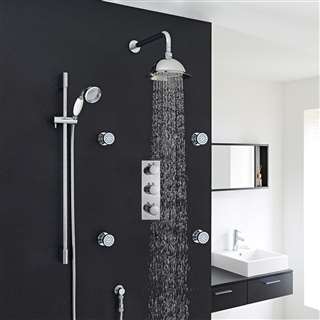 Massage Body Shower Set
Massage Body Shower Set
With its comprehensive design, the body massage chrome Thermostatic Shower System offers a comprehensive bathing solution. It combines temperature control, sleek aesthetics, and invigorating massage functionality to create a spa-like experience in the comfort of your own bathroom.
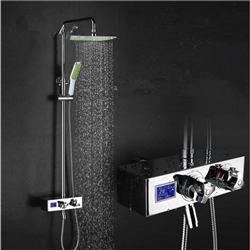 Digital Display Exposed Shower
Digital Display Exposed Shower
The Intelligent Shower Set combines modern design, user-friendly controls, and sustainability. Its intelligent features and digital water-powered technology make it a convenient and eco-friendly choice for your bathroom, offering a delightful shower experience with enhanced control and efficiency.
Body Massage Shower System
One of the standout features of this shower system is the body massage function. It incorporates adjustable body massage jets strategically positioned to deliver a therapeutic water massage. These jets emit a powerful and pulsating water flow, targeting specific areas of the body to help relieve muscle tension and promote relaxation.
Explore Exceptional Shower Systems to Suit Your Style and Budget
Variety of Shower Heads to Choose From
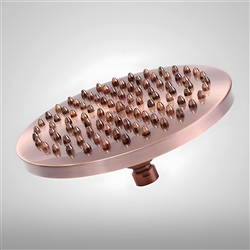 Rainfall Showerhead Antique Red Copper
Rainfall Showerhead Antique Red Copper
The Rainfall Showerhead Antique Red Copper is a somewhat alluring antique-inspired showerhead that gives elegance and charm to your bathroom. Made to detail, this stunning red copper finish manifests timelessness. The round showerhead is tailored with numerous nozzles, equidistantly spaced apart from one another, imitating the effect of rainfall. This luxurious showerhead gives liberal and soaking coverage, surrounding the entire body with a falls-like waterfall of droplets to create an indulgent shower experience. With this Antique Red Copper finish, it provides both enhancement of the look and durability with resistance to tarnish. With its style, functionality, and vintage appeal, this rainfall shower head transforms any shower into a wonderful sanctuary for delightful vision and pampering. Besides its stunning look, this rainfall showerhead serves good flow. It has well-engineered nozzles and a water distribution system that ensures an undisturbed and abundant supply of water sufficient to provide maximum coverage of the soothing ‘rainfall’ effect. It is the best showerhead, exquisitely designed and with a high flow rate—just the perfect combination for gorgeous looks and excellent functionality. Feel the delight of refreshing and rejuvenating with a shower while the water flows, cascading gracfully from the Rainfall Showerhead around you in a luxurious and pleasing bathing experience.
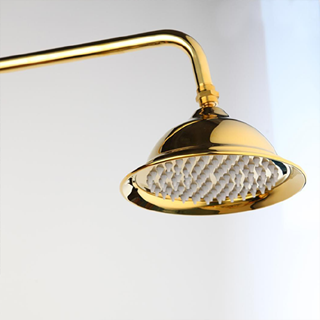 Reno 8 Inch Round Brass Copper Rain Shower Head
Reno 8 Inch Round Brass Copper Rain Shower Head
Introducing 8 inch Round Brass Copper Rain Shower Head—one of the most exceptional shower heads both in design and performance. This stylish shower head is manufactured to precision with elegance and has a very catchy, round shape that gives a touch of modern sophistication to any bathroom. The brass copper finishing enhances its esthetics, making it such a stunning focal point capable of easily and duly matching with any decor. Offering a luxurious shower experience, much like rainfall, this product envelopes the user in a cascade of gentle droplets. It provides the ultimate relaxation with the brass construction for durability and a copper finish that infuses warmth and classic charm. Take your shower experience to the next level of luxury and enjoyment. The Reno 8 Inch Round Brass Copper Rain Shower Head is a perfect mix of unique design and excellent functionality.
Oil Rubbed Bronze Round Rainfall Showerhead
This is an exquisite Oil Rubbed Bronze Round Rainfall Showerhead that will add beauty to enhance your shower experience. Constructed to provide a beautiful oil-rubbed bronze finish, this showerhead exudes a touch of classic elegance and sophistication that can prove captivating as a focal point in your bathroom. Its round shape design adds a hint of modernity and sleekness, blending with any style. This shower head will give you a truly glorious, rainfall-like flow that dispenses the water in an easy, gentle cascade to refresh skin. It’s been crafted for durability, so this rain shower head will last awhile, while the oil rubbed bronze finish adds warming depth to the space. Step up your shower routine with the mesmerizing beauty and exceptional functionality of this Oil Rubbed Bronze Round Rainfall Showerhead for a spa experience every time in the comfort of your own home.
Luxury Shower Heads
Wether you are looking for Waterfall Shower Heads or Rainfall Shower Head, browse our selection and check out at different features, styles, and finishes of the showerhead. We also carry eco-friendly water-powered LED shower head in various sizes and finishes.
High-flow Shower Heads
BathSelect understands that some individuals prefer a higher flow rate for their showers, as it can provide a more immersive and spa-like experience. The high-flow shower head from BathSelect are specifically designed to meet this preference, offering a robust water flow that can help create a rejuvenating showering experience.
It’s important to keep in mind that water conservation and efficiency are important considerations in many states and regions. Therefore, even if high-flow showerheads are allowed, it is recommended to opt for water-saving shower heads to contribute to sustainable water usage practices.
BathSelect offers high-flow showers that provide a generous amount of water for a satisfying shower experience. These high-flow are designed to deliver a strong and invigorating water flow, ensuring a refreshing and enjoyable shower.
Waterfall Shower Head
When selecting a shower head from BathSelect, you can explore their range of options to find the one that suits your desired flow rate. It’s important to check the product specifications and look for information regarding the flow rate or gallons per minute (GPM) to ensure it meets your desired level of water flow.
Keep in mind that while high-flow showerhead provide a generous water flow, it’s also important to consider water conservation and efficiency. BathSelect offers a variety of showerhead with different flow rates, including options that are designed to be more water-efficient while still delivering a satisfying shower experience.
By choosing a high-flow shower head from BathSelect, you can enjoy a powerful and invigorating shower while maintaining the quality and performance that the brand is known for.
Showers vs. Baths
Shower spa consumption includes the water usage of the soap/shampoo shower required after the spa event. a person that takes long showers or uses a high flow rate showerhead can conserve water by using a shallow bath instead. In most cases, but not all, showering is more water efficient than using a bathtub under typical circumstances.
While bathtub water usage is indifferent to a duration of the event, water usage from showers is greatly influenced by durations. It is important to eliminate other activities when showering. For example, shaving while in the shower can double or triple the amount of water used. These activities are better managed while taking a bath, rather than a shower because the bath water usage remains constant.
Rainfall Shower Head
“Navy Showers” and Lathering Valves An additional method to reduce water use in showers is to turn off the water while lathering and shampooing, often called a “navy shower”. The method requires three steps: 1) turn on the water to rinse body and hair; 2) turn off the water while shampooing hair and washing body with soap and washcloth; 3) resume water flow and rinse off all shampoo and soap.
Using this technique, the total duration of water flow can be reduced to 5 minutes or less. This is more easily performed when an on-off or lathering valve is attached to the showerhead so the water temperature remains properly adjusted at the desired level. Many water efficient showerheads have integral shut-off valves already attached. Separate “shut-off” or “lathering” valves can be purchased at many hardware stores, and are easily installed between the shower neck and the showerhead. Many organizations (including manufacturers) promote the installation of these showerheads.
Beware of Thermal Shock and Scalding: Caution with Showerhead Shutoff
While such a lathering valve appears to enable the user to save water, not all homes can use the device. In some cases, it also might endanger that user and lead to thermal shock and/or scalding when the water flow is resumed. In households where the water pressure on the cold water side differs from that on the hot water side (most often where a hot water re-circulating pump exists), closing this small valve could result in hot water flowing into the cold water leg or vice-versa.
Depending upon the length of time the valve is closed and the variance in line pressures, when the valve is opened, the temperature of the water exiting the showerhead can be significantly different than it was prior to closure.
This sudden temperature shift results in a shock to the body (potentially causing a slip and fall) and possibly scalding in those instances where hot water has backed into the cold water line. For these reasons, showerheads with integral shut-off valves or separate valves designed to be installed between the shower arm and the showerhead are not recommended in the following cases: (1) pre-1987 homes where no scald protection valve is installed behind the wall; (2) showers with flow rates below 2.0 gallons per minute (7.6 Lpm); and (3) showers that are used by elderly or infirm people more easily subject to thermal shock, slipping and falling.
For more information on the hazards associated with scalding and thermal shock in the shower, read this white paper by the American Society of Sanitary Engineers. Read this warning statement now being attached to plumbing and green building codes and standards in North America. Read this article in Home Energy Magazine regarding the topic of scalding and thermal shock. Read this very descriptive article on automatic compensating valves in Plumbing Engineer magazine.
Shower Spray Types
Most showerheads are designed to produce a water spray in one of three major categories: a) stream spray; b) atomizing spray; or, c) aerating spray. Individual preferences determine user satisfaction among the different types of spray. Each type has advantages and disadvantages. Stream spray showerheads emit the water in many (often more than 20) small continuous streams, and the streams are set in a circular pattern to balance coverage area and comfort. Most users find the water temperature remains fairly constant, but the velocity of the water emitted is somewhat hampered by the need to retain water flow below 2.5 gpm (9.5 Lpm).
.jpg)
Atomizing showerheads use the turbulence of the water passing through the head to create water droplets, and emitting these droplets at high velocity. Most users find the high velocity of the water to be pleasantly invigorating and assisting the rinsing of shampoo from thick hair. The spray pattern is circular, and more filled-in compared to stream spray heads. The disadvantage is the small water droplets tend to cool down quickly as they pass through the air. Some users complain of the water spray feeling hot on their shoulders while cold on their lower legs.
This cooling effect also caused an updraft of air in the shower stall, which causes billowing of shower curtains during the shower. Atomizing spray heads were very popular with utility conservation programs in the 1980s and 90s, partially due to the low cost of manufacturing. Advancements in alternate designs and concerns for customer satisfaction has made these models less popular
Aerating showerheads are very similar to atomizing models, with the addition of air mixed in with the water inside the head through venturi action. The aeration assists in the water appearing more voluminous to the shower user. Unfortunately, the aeration increases the heat transfer of the water, cooling the water faster than even the atomizing spray.
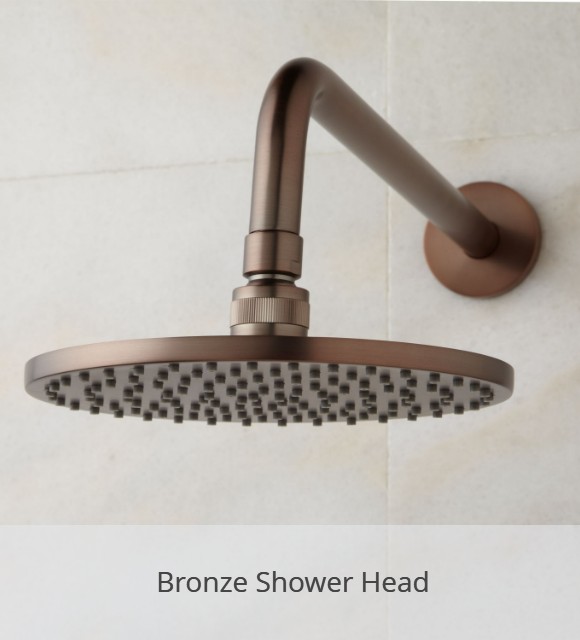
Oil Rubbed Bronze Showerhead
Newer showerhead designs employ multiple sprays types to take advantage of the beneficial aspects of each type of head. These “hybrid” showerheads have resulted in greater consumer satisfaction and water savings. A utility planning to implement a showerhead replacement program should choose products very carefully. Dissatisfied users will remove the showerhead, or tamper with the flow controls; resulting in no water savings. Only the showerheads that remain installed and used will save water for the utility and customer.
Re-circulating Showers
With rare exception, re-circulating showers are not designed or operate in a water-efficient manner. These systems are often called “vertical body spas” and they often use more water than a typical shower or bath. The re-circulation pumps require a reservoir of water in the shower basin to properly operate. Some makes and models of these systems require more than 45 gallons (170 liters) of water in the basin – more than twice the water usage of a typical shower.
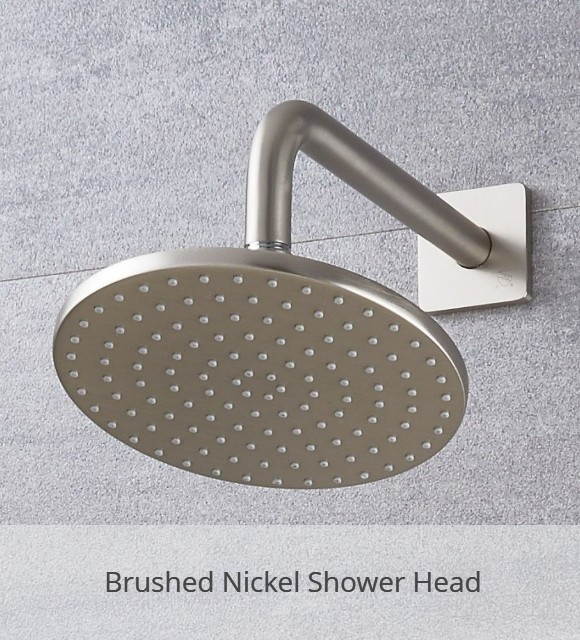
The user cannot use any soap or shampoo during the system operation; the spray heads would start emitting suds at a very high velocity and may also clog the head. The user must take a “real” shower after the re-circulating shower, adding additional water usage to the event.
Negative Trends in Residential Systems Two trends are troubling to water efficiency advocates in North America: Multiple Showerheads in a Single Stall There is a growing trend to install multiple showerhead systems in single user shower stalls (compartments) in homes. While not illegal, such systems subvert the intent of the Federal maximum of 2.5 gpm (9.5 Lpm) flow rate for showerheads as contained within EPAct 92. Fortunately, nearly all of the North American green codes and standards are addressing the multiple showerhead issues by defining the size of a showering stall and next specifying the maximum cumulative flow of all the showers and other water emitters within the stall.
Water efficiency advocates are encouraged to support efforts to restrict showerhead installations to no more than one showerhead per 1,800 square inches (1.2 square meters) of shower stall floor area and require showerheads to be at least 36 inches apart (0.9 meters). This proposed requirement would not allow a second showerhead to be installed unless the shower stall size exceeded 1,800 square inches (1.2 square meters).

Since 1994, federal regulations have limited shower head manufacturers to a maximum flow rate of 2.5 gallons per minute (gpm). California has enacted its own legislation limiting the flow rate to 2.0, and reduced even further, to 1.8 gpm, in July 2018. Water flow regulations save billions of gallons of water each year while the latest technologies help preserve or even enhance your shower experience. There’s no need to suffer a substandard showering experience just because of regulations.
The shower designs that prioritize environmental sustainability should not come at the cost of performance. In the past, a typical showerhead typically used 5.5 gallons per minute (gpm) of water. However, regulations restricting flow rates to 2.5 gpm have led to the development of a new generation of water-saving showerhead. If you switch from an older shower head produced before 1994 to a modern model, you will notice a significant change in the flow rate. Despite these restrictions, it’s important to prioritize consumer satisfaction and ensure that the showering experience remains enjoyable and effective for customers.
Spray Force shower head (sufficient to provide user satisfaction) , and the Spray Coverage ordistribution pattern showerheads are very important factors for measuring showerhead performance and considered the main two criteria that influence user satisfaction
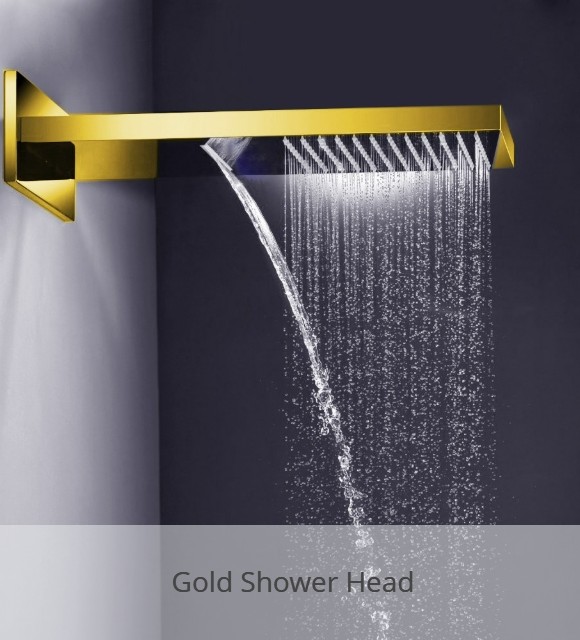
General FAQs:
What is Shower Gallons Per Minute?
When it comes to showers, “gallons per minute” (GPM) refers to the rate at which water flows from the showerhead. It is a measurement used to determine the water efficiency and the amount of water consumed during each minute of showering.
The GPM value represents the volume of water in gallons that flows through the showerhead in one minute. It indicates the flow rate and can vary depending on the type of showerhead, the water pressure, and any flow restrictors or water-saving features that may be in place.
The GPM rating is an important factor to consider when selecting a showerhead or evaluating water usage in your home. Higher GPM values indicate a higher flow rate, which means more water is being used per minute. Conversely, lower GPM values indicate a lower flow rate and, therefore, less water consumption.
In recent years, there has been a growing emphasis on water conservation and efficiency, leading to the development of low-flow or water-saving showerheads. These showerheads are designed to limit the flow of water while still providing a satisfying shower experience. They often have a GPM rating of 2.0 or lower, significantly reducing water usage compared to older, less efficient models that can have GPM ratings of 2.5 or higher.
It’s worth noting that while low-flow showerheads are more water-efficient, they can still provide a pleasant shower experience by incorporating features like aerators or special spray patterns that optimize water distribution.
To determine the GPM rating of your showerhead, you can check the product specifications provided by the manufacturer or look for a label on the packaging. It’s important to choose a showerhead that meets your desired flow rate while balancing water conservation.
By considering the GPM rating and opting for water-saving options, you can contribute to water conservation efforts, reduce your water consumption, and potentially lower your water bills without compromising your showering experience.
What is Average Shower Flow Rate?
The typical average shower flow rate falls within the range of 1.5 to 2.5 gallons per minute (GPM), which is equivalent to approximately 5.7 to 9.5 liters per minute (LPM). This means that during a minute of showering, water flows from the showerhead at a rate between 1.5 to 2.5 gallons or 5.7 to 9.5 liters. Although the specific flow rate within this range can vary based on factors such as the design and type of the showerhead. Some showerheads are designed to deliver a higher flow rate for a stronger water pressure, while others are engineered to be more water-efficient and provide a lower flow rate.
It’s important to note that the actual flow rate of a shower can also be influenced by local regulations and personal preferences. In some regions, there may be water conservation regulations that require showerheads to have a maximum flow rate of a certain value, typically aiming for greater water efficiency.
Incorporating few strategies into your shower routine, can make a significant impact on water conservation. Here are a few approaches to help conserve water:
- Replace your current showerhead with a low-flow or water-efficient model. These showerheads are designed to restrict water flow while maintaining a satisfying shower experience. They often include features like aerators or flow restrictors to reduce water consumption without compromising water pressure.
- Be mindful of the time you spend in the shower. Shortening your shower duration can significantly reduce water usage. Set a timer or use a waterproof shower timer to keep track of your shower time and aim to keep it within a reasonable limit.
- Adopt the practice of a “Navy shower” or “military shower.” This involves turning off the water while lathering up with soap or shampoo and then turning it back on solely for rinsing. This method can drastically reduce water wastage during the showering process.
- Adjust the temperature settings before getting into the shower to avoid wasting water while waiting for it to reach the desired warmth. Consider installing a thermostatic valve or temperature regulator to have better control over water temperature, minimizing the need for adjustments during the shower.
- Consider using a bucket or basin to collect excess water while waiting for it to warm up or during the initial stages of the shower. This captured water can be repurposed for activities like watering plants or cleaning.
- Be Mindful of Faucet Usage; while in the shower, be conscious of water usage when adjusting the water flow or turning it off temporarily, such as when applying shampoo or conditioner.
- Ensure that your showerhead and plumbing fixtures are in good condition. Leaks or drips can result in significant water waste over time, so promptly address any issues by repairing or replacing faulty components.
The Perfect Shower Head Water Flow: This blog post explores the evolution of showerhead designs aimed at improving water conservation while maintaining performance. It highlights the impact of federal regulations that limit flow rates to 2.5 GPM and explains how modern designs ensure an efficient yet satisfying shower experience. BathSelect
Can My Showerhead’s Flow Rate be Increased?: This article addresses common questions about increasing showerhead flow rates, discussing factors like flow restrictors, water pressure, and maintenance tips to optimize shower performance. BathSelect
What is a Showerhead Flow Rate?: This page provides an overview of showerhead flow rates, explaining their significance, measurement in gallons per minute (GPM), and the importance of balancing water conservation with user satisfaction. BathSelect
The Evolution of Showerhead Flow Rates in the U.S.: This article examines the historical changes in showerhead flow rate standards in the United States, discussing regulatory impacts and advancements in showerhead technology aimed at enhancing water efficiency. BathSelect
Premium High-Pressure Rainfall Waterfall Shower Heads: This blog post reviews high-pressure showerheads, focusing on their design, functionality, and how they enhance water flow to provide a luxurious shower experience. BathSelect Blog
Shower Head Best: This blog post reviews various showerheads, focusing on their water flow rates and performance. It provides insights into selecting the best showerhead to enhance your shower experience. BathSelect Blog
Top Shower Head Brands Reviews: This article evaluates different showerhead brands, emphasizing their design, functionality, and water flow efficiency. It assists consumers in making informed decisions when choosing a showerhead. BathSelect Blog
Unique Design Rain Showerheads: This page showcases a selection of rain showers with unique designs, highlighting their water flow characteristics and how they contribute to a luxurious shower experience. Bath Select
Temperature Sensor Color Changing LED Shower Head: This blog post discusses LED showers equipped with temperature sensors that change color based on water temperature, enhancing the shower experience. BathSelect Blog
Why LED Shower Head Lights Not Working? We Have The Answer!: This article addresses common issues with LED showers, including problems related to water flow and maintenance tips to ensure optimal performance. BathSelect Blog
How to Increase Water Pressure in Shower: This article offers practical solutions for improving shower water pressure, including cleaning showerheads, checking for obstructions, and considering high-pressure showerhead options. BathSelect Blog
How Many Gallons of Water Does a Shower Use?
The amount of water used during a shower can vary depending on several factors, such as the duration of the shower, the flow rate of the showerhead, and personal bathing habits. However on average, a standard showerhead in the United States has a flow rate of around 2.5 gallons per minute (GPM).

Food and Water Resources
A typical shower in the United States uses approximately 17.2 gallons of water. This estimation is based on an average shower duration of 8 minutes and a standard showerhead with a flow rate of 2.5 gallons per minute (GPM). Assuming the typical shower duration of 8 minutes, the water usage would be calculated as follows:
Water Usage = Flow Rate (GPM) x Shower Duration (minutes)
Water Usage = 2.5 GPM x 8 minutes
Water Usage = 20 gallons
Therefore, an average 8-minute shower with a standard showerhead would use approximately 20 gallons of water. It’s important to note that this is an estimation, and actual water usage may vary depending on individual circumstances and the specific showerhead used. Additionally, using water-efficient showerheads or implementing water-saving practices can significantly reduce the amount of water consumed during showers.
How to Convert LPM to GPM?
To convert liters per minute (LPM) to gallons per minute (GPM), you can use the following conversion factor:
1 LPM = 0.264172052 GPM
Multiply the LPM value by 0.264172052 to obtain the equivalent flow rate in GPM. Here’s an example:
Example: Convert 10 LPM to GPM 10 LPM * 0.264172052 = 2.64172052 GPM
Therefore, 10 liters per minute is approximately equal to 2.64 gallons per minute.
How Many gpm is a shower?
To know the exact GPM of a specific shower head, one should check the product specifications or markings on the shower head itself.
If you are not sure and the manufacturer does not provide gpm shower flow rate you can apply hands-on, real-world measurement of your shower’s flow rate, which can be especially useful if you’re unsure about the manufacturer’s specs or if the shower head is older and may not meet modern standards.
To elaborate follow these steps:
- Set Up: Place a measuring container (like a bucket or a large measuring cup) under the shower.
- Run the Shower: Turn the shower on at the pressure you usually use.
- Time It: Let the water run into the container for exactly 60 seconds. Use a timer or stopwatch for accuracy.
- Measure: After 60 seconds, turn off the shower and measure the amount of water collected.
- Determine GPM: If you used a gallon container and it’s filled up, the amount represents the GPM. If you used a different measurement (like quarts or liters), you’d need to convert it to gallons per minute. For example, if you collected 2 quarts of water in 60 seconds, that’s equivalent to 0.5 gallons per minute.
High Pressure Shower Head
When a shower head is designed to deliver water at a higher pressure compared to standard showerheads, i.e. refers to the capability of the shower head to increase water flow intensity, hence a shower head is termed high pressure shower head. Here are some factors that can qualify such a shower head to be termed as “High Pressure”:
- Design and Nozzle Configuration: Many high-pressure shower heads have unique nozzle designs or jet patterns that amplify water pressure, even if the home’s water pressure is average or below average.
- Flow Rate: While standard shower head in the U.S. typically have a flow rate of 2.5 gallons per minute (GPM) due to federal regulations, a high-pressure shower head can feel much more intense even at this rate because of its design and how it disperses water.
- Pressure Chamber or Air-Intake Design: Some high-pressure shower heads are equipped with a pressure chamber or use an air-intake system to inject air into the water. This can increase the force and intensity of the water flow.
- Adjustability: High-pressure showerheads often come with adjustable settings that allow users to change the water pressure according to their preferences.
- User Reviews and Feedback: Often, the “high pressure” claim is backed up by user reviews and feedback. Customers who have experienced an increase in pressure compared to their previous showerhead can attest to its high-pressure performance.
- Performance in Low-Pressure Situations: A true high-pressure shower head should be able to deliver a stronger water flow even in homes or buildings where the water pressure is naturally low.
Water Conservation
- Efficiency Upgrades:
- Installing water-efficient fixtures and appliances can reduce water consumption by at least 20%. For example, replacing old toilets, showerheads, and faucet aerators with WaterSense labeled models can save significant amounts of water and reduce utility bills (US EPA) (US EPA).
- A household can save up to 13,000 gallons of water annually by upgrading to WaterSense labeled toilets, showerheads, and faucet aerators (US EPA).
- Behavioral Changes:
- Simple changes such as running dishwashers and washing machines only when full, fixing leaks promptly, and using efficient irrigation methods can contribute significantly to water savings (US EPA).
Conclusion
Understanding and addressing water usage and waste are crucial for sustainability. By implementing water-efficient technologies and adopting water-saving habits, significant reductions in water consumption and waste can be achieved, promoting better resource management and environmental conservation.
Chrome vs. Brushed Nickel Bathroom Fixtures: What Is the Difference? Chrome and brushed nickel are two most widely used bathroom fixture finishes, each differently advantageous. Chrome fixtures, normally having a thin layer of electroplating with chromium, possess a very reflective, mirror-like surface that looks great with modern and minimalist settings. The finish doesn’t tarnish much, and it has a sleek, clean look; however, there can be issues with water spots and fingerprints, so it tends to need quite a bit of ongoing maintenance. Brushed nickel features subtle, matte finish with fine texture provided by wire brushing or abrasives. This finish presents a warm, mellow tone, which works well with traditional or transitional styles. Brushed nickel is more forgiving in terms of fingerprints and water spots, requiring less cleaning than polished. On the other hand, because of its textural finish, it tends to let dirt and grime fill its crevices over time, also due to the more intricately tactile nature of the metal. Technically speaking, both finishes are durable, though the manufacturing process for brushed nickel is more labor-intensive, making this finish a little pricier. This is often a question of aesthetic preference and maintenance requirements.
Flow of Water from a Shower Head The question of the flow of water from a shower head is determined by a number of technical factors flowing rate, water pressure, and the engineering of the shower head itself. Federal law in the U.S. has imposed a restriction of 2.5 GPM at 80 psi to conserve water, although newer models may have lower flow rates and have no effect on performance. In fact, the way the internal nozzle structure is designed in a shower head enables the volume and direction of water flow to be controlled properly. Some air-injection shower head technology that mixes air with water to enhance the pressure without consumption, hence yielding a more forceful shower experience even at lower flow rates. Distribution and intensity also continue to vary with spray patterns, which can be adjusted by design: rain, massage, and jet modes for an increasingly personalized experience. Apart from this, the flow restrictors that are installed to meet the requirements set for environmental safety also contribute to water consumption reduction. The right choice of shower head for your plumbing system can guarantee optimal performance since low water pressure significantly lessens the efficiency and comfort of the shower.
Brushed Nickel Shower vs. Stainless Steel Showers Brushed nickel and stainless steel showers have been two extremely durable finishes in the shower systems, but they have different properties. Brushed nickel is a softer, warmer finish that is achieved by brushing the surface of the metal to create a subtle texture. Its matte look makes it very good at hiding fingerprints and water spots, thus perfect for high-traffic showers where maintenance might be a challenge. On the other hand, stainless steel is generally finished to a smooth polish and is noted for its resistance to corrosion and strength, particularly in areas with much moisture, such as showers. In fact, stainless steel has a much cooler industrial look that works well in modern bathrooms. Technically speaking, stainless steel showers are at an advantage over rust and tarnish because the presence of chromium forms an invisible layer of oxide on the surface that acts to inhibit corrosion. While brushed nickel holds up most against wear and tear regarding concealment of minor scratches and fingerprints, stainless steel tends to outlast it in pure durability and resisting agents facilitating tough cleaning or high humidity. In the final analysis, options will often depend upon aesthetic preference and on the level of maintenance the user is willing to commit to.
Brushed Nickel vs. Polished Nickel Both brushed nickel and polished nickel finishes have their own unique aesthetic appeals and functional benefits; however, they are rather different in appearance and maintenance. The finish of the brushed nickel is soft and textured, made by brushing the surface with abrasives giving a soft, muted satin look. The finish does a more excellent job of hiding fingerprints, water spots, and minor scratches. Therefore, it is suitable for busy homes or commercial settings that have constant use of fixtures. The polished nickel boasts of a smooth, highly reflective finish that resembles chrome but in a warmer tone. Nickel polished gets its lustrous finish by polishing and electroplating processes; this gives a bright and mirror-like finish. On the downside, this reflective surface tends to show more smudges, water spots, and tarnishing, hence requiring frequent cleaning to maintain the shine. Technically speaking, both finishes are quite durable and resistant to corrosion, but brushed nickel is more lenient on maintenance. In contrast, polished nickel boasts a lovely arresting look that is more practical for areas with lower traffic or the end-user who likes it a bit more luxurious and high maintenance.
Brushed Gold Shower Systems vs. Shiny Gold Shower Systems Brushed gold and shiny gold shower systems present two different aesthetic options, each with different technical specifications. The brushed gold features a discreet, matte finish that is achieved by brushing on the surface with the intent of reducing its reflective quality. Warm and radiating in subtle elegance, it is suitable for both classic and modern bathroom designs. The textural finish will also have the added benefit of hiding fingerprints, water spots, and minor scratches quite easily and prove to be more appropriate in high-use situations that require low maintenance. In contrast, shiny gold is a more opulent, reflecting surface-one speaking of luxury and glamour. This bright, highly polished finish is achieved by polishing and then electroplating. It is brilliant but tends to show smudges and water spots, so needs regular cleaning to maintain brilliance. Technically, the two finishes are robust, being applied over substrates of either brass or stainless steel for added corrosion resistance. However, brushed gold tends to be more practical for everyday use, while shiny gold is ideal for anyone looking to make a statement in their bathroom. This choice between the two finishes often has to do with finding a balance between aesthetics and ease of maintenance.
Oil Rubbed Bronze versus Antique Bronze Oil rubbed bronze and antique bronze are two finishes that are in high demand, adding a touch of richness and classic style to bathroom fixtures; however, they vary in looks and manufacturing processes. Oil rubbed bronze is usually attained through chemical processes which darken the surface of the metal to a deep, almost black finish with subtle copper undertones. The finish is sleek, smooth, and often applied in traditional or rustic bathroom settings. On the other hand, antique bronze is artificially aged on the surface layer to give it that worn, aged look of time. It has a lighter look that is more textured and often bears streaks or patina that enhance its appeal for vintage purposes. On a technical note, oil rubbed bronze is color and texture consistent, whereas antique bronze varies based on the depth of the finish and the aging process used. For special care, as with either finish, tarnishing must be prevented, and to preserve their respective looks, harsh cleaning agents strip away the patina or darkened surface. Although both finishes boast a feeling of durability and timelessness, oil rubbed bronze is used to offer a more modern feel to an otherwise classic style, while antique bronze uses mostly traditional and old-world aesthetics.
This article covers the following topics:
| rain shower head |
| how much water does a shower use |
| how many gallons of water does a shower use |
| shower gallons per minute |
| shower gpm |
| shower head gpm |
| how many gpm is a shower |
| how many gallons per minute shower |
| shower head flow rate |
| how many gallons in a shower |
| how many gallons per minute in a shower |
| average gallons per shower |
| how many gallons per minute does a shower use |
| how many gallons per minute is a shower |
| standard shower head gpm |
| how many gallons of water in a shower |
| gallons per minute shower |
| how many gpm for shower |
| how many gallons does a shower use |
| how much water does a shower use per minute |
| what uses more water a shower or a bath |
| shower flow rate |
| how many gallons per minute for shower |
| high flow showerhead |
| how many gallons of water for a shower |
| low flow shower head gpm |
| gpm flow rate |
| average shower head gpm |
| how much water does the average shower use |
| average shower gpm |
| how many gallons per shower |
| gallons per minute in shower |
| shower water usage |
| average gallons per minute shower |
| shower head gallons per minute |
| how many gpm does a shower use |
| gpm shower |
| high volume shower head |












.jpg)






